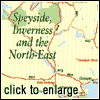|
The Road North (A9)
Golspie is a pleasant little town with an excellent
18-hole golf course that offers a variety of playing conditions. On Golspie's Main
Street is found the Orcadian Stone Company where a world-wide collection of fine
minerals, Highland rocks and fossils are displayed.
 A mile or so beyond Golspie stands Dunrobin Castle, the most
northerly of Scotland's great houses and seat of the powerful Sutherland family.
From the main entrance, which is at the rear of the castle, Dunrobin does not appear
overly impressive. From its seaward side it stands like a sprawling Bavarian palace
above immaculately manicured gardens. This is an excellent example of Victorian over-exuberance
taking the idea of Highland romanticism to the extreme. A mile or so beyond Golspie stands Dunrobin Castle, the most
northerly of Scotland's great houses and seat of the powerful Sutherland family.
From the main entrance, which is at the rear of the castle, Dunrobin does not appear
overly impressive. From its seaward side it stands like a sprawling Bavarian palace
above immaculately manicured gardens. This is an excellent example of Victorian over-exuberance
taking the idea of Highland romanticism to the extreme.
Originally, this site was occupied by an ancient broch
or defensive tower, which was subsequently replaced by a thirteenth century structure.
Inside the present castle is a dusty, dark hodge-podge of displayed items, some quite
magnificent such as the two Canaletto paintings. The museum, housed in a separate
building overlooking the gardens, was previously William, Earl of Sutherland's summer
house. There is a gift shop and Castle Buffet.
Continuing north on the A9, just beyond Dunrobin,
Carn Laith Broch is easily seen from the highway. There is parking on the west side
but care must be taken in crossing the road. This defensive structure, dating from
the Iron Age, is worth closer inspection as much of its construction is below ground
level. The dry-stone tower was used as a refuge in times of attack.
Brora
The friendly little town of Brora is a couple of miles
on. With wonderful beaches around Kintradwell Bay, fishing for trout and salmon on
the River Brora and an excellent 18-hole James Braid designed golf course, it is
worth considering Brora as a base to tour this part of the north-east. The two main
hotels are the Royal Marine on Golf Road and the nearby Links Hotel. Both are commended
for their high standards and plentiful facilities. The Links overlooks the golf course
while the Royal Marine offers a leisure suite with swimming pool, sauna, steam room
and whirlpool, all available to Links Hotel guests. There is also an exercise room
and, through the winter months, a curling rink. The Garden Café in the Royal
Marine is highly recommended for lunch while more formal settings for excellent evening
meals are available in both hotels.
A cheaper accommodation alternative in this area is
Tigh Fada B&B on Golf Road. Ishbel Clarkson's breakfasts are renowned including
locally smoked haddock or fried herring in oatmeal. Her fried apple rings served
with a traditional Scottish breakfast are a refreshing addition. The main bedrooms
and breakfast room look over the golf course and sea.
The course at Brora is renowned for its natural golfing
terrain as well as the cows and sheep that are free to roam the common grazing land.
Electric fences are installed to protect the greens, which, through the summer months,
are amongst the fastest in Scotland.
Hunter's of Brora is a famous knitwear factory with
an outlet found in Station Square. Capaldi's Ice Cream parlour is worth a visit on
main Rosslyn Street and for stronger taste buds, there is the Clynelish Distillery
just off the main street, which is open for tours and tastings.
About five miles before the village of Helmsdale,
a worthwhile drive inland is found at the signposted but easily missed turning for
Glen Loth. Along this twisting, single track road is some of the most primeval Scottish
landscapes offering a good chance to spot deer and perhaps the elusive Golden Eagle.
It is possible to take this route inland then turn back towards the A9 at the Strath
of Kildonan following the A897 into Helmsdale. The entire drive would take around
one hour without stops.
Helmsdale
The village of Helmsdale is set on a craggy headland
with its harbour squeezed into a cleft between the rocks. On a dull day it might
appear grey and uninviting but it is worth a stop as there are quite a few things
to discover.
The most obvious attraction is the Timespan Heritage
Centre that reaches back into the distant past to consider the stone circles and
cairns that are abundant in these parts. As well as the Vikings and Picts, there
is a section explaining well the Highland Clearances and also the Kildonan gold rush.
There are still specks of gold to be found in the burns up the Strath and panning
equipment and directions can be obtained from the Strath Ullie shop in Helmsdale.
This is also the main stop for fishing equipment and permits for fishing the excellent
Helmsdale River.
As if to combat the inherent greyness of the village,
one local lady has created such a splash of colour that stars of television, film
and literature are among her many visitors. 'La Mirage' tea-room and 'Take-Away'
is one of the most flamboyant places of its kind in Britain.The authoress, Barbara
Cartland, has a holiday home near Helmsdale and the owner of the cafe, Nancy Sinclair,
a devout fan, has, for many years, modelled her appearance on Miss Cartland. The
tea-room, complete with its pink sugar, palm trees, flying flamingos and a myriad
of photographs showing the owner with some of her most famous visitors, is a must
to see. The food is also quite good.
Further up the A9 is another unusual stop, the Kingspark
Llama Farm near Berriedale. Brian and Mary Gough started this fascinating farm 9
years ago as a caravan site and B&B that has developed into a miniature menagerie.
Beside the herd of llamas, other animals include pigmy goats, peacocks, racoons,
golden pheasants and wallabies. The llamas can be taken on walks (Thursday's and
Sunday's) where they carry back-packs containing lunch. This, including the picnic,
can take around four hours. Telephone 01593 751202 to make arrangements.
Further on, a fifteenth century castle is just visible
from the road. This is part of the Dunbeath Estate, now owned by a Californian millionaire,
Ray Stanton Avery of sticky label fame, who has done much to restore the estate and
the villages within it. The castle is not open to the public. A Heritage Centre gives
information on the author Neil Gunn who was born here, as well as local history and
wildlife.
The road to Wick
 The road is quite desolate between Helmsdale and Wick so you
cannot fail to see the Laidhay Croft Museum off to the right, a popular stopping
place for coach parties. Inside the reconstructed croft is an emporium of memories
for senior travellers, old biscuit tins, and newspaper cuttings from the wars and
ancient pedal sewing machines. There is a nice little tea-room opposite as well as
an out-building containing rusting farming equipment. Further on, in an old parish
church looking over the turbulent North Sea, is the Clan Gunn Museum and Heritage
Centre. The road is quite desolate between Helmsdale and Wick so you
cannot fail to see the Laidhay Croft Museum off to the right, a popular stopping
place for coach parties. Inside the reconstructed croft is an emporium of memories
for senior travellers, old biscuit tins, and newspaper cuttings from the wars and
ancient pedal sewing machines. There is a nice little tea-room opposite as well as
an out-building containing rusting farming equipment. Further on, in an old parish
church looking over the turbulent North Sea, is the Clan Gunn Museum and Heritage
Centre.
The fishing port of Lybster is the next town. Turn
off the A9 into the broad main street. There is really nothing here apart from the
picturesque harbour. The Portland Arms Hotel is a pleasant stop for food. At Clyth
a couple of miles on is a minor turning north to the Grey Cairns of Camster, a collection
of burial mounds from around 2500BC.
Nearby, a l/2 mile off the A9 near Kyleburn is the
Hill o' Many Stanes, a desolate group of early Bronze Age stones, some 200 in all,
spread over a heather crest. Erected in the second millennium BC, their average height
is only 18 inches and they are laid out in a fan-shape. Their purpose, as with most
such artefacts, is unknown.
The last stop before Wick is the fishing village of
Ulbster. There is little to see in the village, but drive through to the cliffs which
are forbidding and, on a bad day, the wind can blow sea water straight up the sheer
cliff walls. There is a narrow stairway leading down to a tiny, rock strewn harbour
with 365 steps to negotiate. Now overgrown, it can be very slippery. It is hard to
believe that fishermen would bring their boats right in to the churning cove to unload
the fish and the village women would carry the catch back up these steps.
Wick
Wick, pronounced Week by the locals who are referred
to as Weekers, became a royal burgh in 1140. Before that it had been primarily a
Viking settlement from which it took its name of Vik, actually after the burn that
runs through it.
The busy little town that we see now only fully developed
in the nineteenth century when Thomas Telford was asked by the British Fisheries
Society to design a model village for them at Pultneytown. This was to help meet
the demand from the herring fishing industry and Wick became the busiest herring
port in Europe. This is the background that established this stalwart little community,
the largest in the north-east after Inverness.
The Wick Heritage Centre, near the harbour, tells
the story in detail, with a superb collection of models, fishing equipment and photographs.
It is run by the Wick Society who take a great pride in their museum. There is also
a small museum within the Carnegie Library, open during library opening times, which
contains a history of the area's fishing and farming communities.
One of the best Wick eateries is the Lamplighter Restaurant,
which has excellent food, especially its sweets. If you stay in the attached B&B
or drop in for breakfast, you might find it a bit too plentiful as they serve a full
Scottish spread followed by American-style pancakes.
 On the outskirts of town, on the 'Groats Road' as referred
to by locals, is Caithness Glass Factory and Visitor Centre. This spacious facility,
lovely and warm on a cold or wet day, offers a chance to see the famous glass-ware
being moulded and blown into the vases and paper-weights that are collected around
the world. There is an opportunity to buy these in their gift shop and restaurant. On the outskirts of town, on the 'Groats Road' as referred
to by locals, is Caithness Glass Factory and Visitor Centre. This spacious facility,
lovely and warm on a cold or wet day, offers a chance to see the famous glass-ware
being moulded and blown into the vases and paper-weights that are collected around
the world. There is an opportunity to buy these in their gift shop and restaurant.
The road leading north out of Wick is still the A9
whereas the A882 carries north-west directly to Thurso. This final stretch of the
A9 sets out over an old red sandstone plateau, a wide flat north-eastern corner of
mainland Scotland edged by abrupt cliffs.Sinclair's Bay is off to the east with Sinclair
and Girnigoe Castles, two ruins accessible by foot and overlooking the bay. Ackergill
Castle has a commanding view over to Duncansbay Head up the coast.
This is a private castle that can be hired by groups
and there is a small golf course just along the bay. Sinclair's Bay is believed to
be one of the earliest inhabited places in Scotland with evidence of Middle Stone
Age man living here in large numbers. This is best explained in the John Nicholson
Museum near Auckingill at the north end of the bay, which unfolds the archaeology
of the area as explored by this nineteenth century antiquarian who spent his life
studying local history.
|



